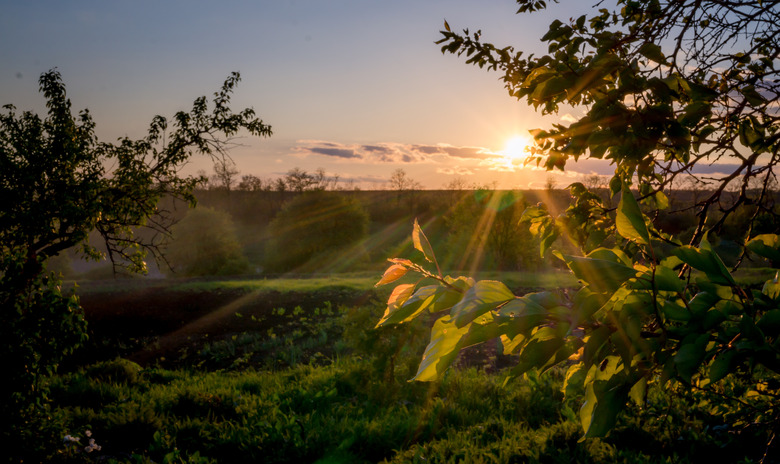Can Photosynthesis Occur At Night?
Just like humans and animals, plants need energy to survive and thrive, and they make their food themselves via a process called photosynthesis, which occurs only in the presence of light. This process takes place in the plant's food-producing chloroplasts, which contain the pigment chlorophyll present in all green plants.
Plants perform this process using light energy and carbon to create nutritional material for themselves. As a byproduct they also create oxygen as a byproduct. This is incredibly vital for the ecosystem of autotrophs (plants and self-sustaining organisms) and heterotrophs (animals, humans, and other organisms that cannot create their own food).
TL;DR (Too Long; Didn't Read)
Plants need light to photosynthesize, but it doesn't necessarily have to be sunlight. If the correct type of artificial light is used, photosynthesis can happen at night with lights that contain blue and red wavelengths.
The Process of Photosynthesis
The Process of Photosynthesis
Plants take in water through their roots, carbon dioxide from the air using stomata and energy from sunlight, and a chemical process involving all three enables them to perform photosynthesis to make glucose and oxygen. Glucose (a type of carbohydrate) travels around the plant as soluble sugars, forming cellulose for cell walls and proteins for growth and repair. Plants use oxygen during photosynthesis to release carbon dioxide into the air through gas exchange, which is known as respiration. In 1779 Dutch biologist and chemist Jan Ingenhousz furthered the work of earlier scientists by providing three things: plants need light to photosynthesize, only the green parts of the plant perform photosynthesis and the environmental benefits of respiration outweigh the damage.
The products of photosynthesis are incredibly vital for the plants themselves and the organisms around their ecosystems. Photosynthesis actually takes place in multiple stages (all involving organelles in the plant cell like the chloroplast). The key components that are important for discussing night-time photosynthesis are the light-dependent and light-independent reactions. Photosynthetic organisms need light to drive their many use of energy when producing sugars and oxygen, but after they successfully absorb the light and convert it to other internal energy sources (like ATP and NADPH which carry energy between processes), the rest of the chemical reactions are actually independent of light entirely – these are known as dark reactions.
TL;DR (Too Long; Didn't Read)
The energy transport in plants and cells takes place with the transfer of electrons. NADPH is a vital electron donor that helps to fuel many of the most essential functions of energy production and usage.
We want to look at this first part of the process, known as the light-dependent reactions. These reactions directly use the energy from visible light to create chemical energy for use in turning CO2 into glucose and oxygen. After this we can look at the light-independent reactions also known as the Calvin Cycle. After the plant has taken in sufficient carbon dioxide, energy, and water it can begin the process of fixing the carbon, reducing it, and then turning it into glucose and oxygen for use in cellular respiration.
Plants and Respiration
Plants and Respiration
Plant respiration uses oxygen to produce energy and give off carbon dioxide as a waste product, which makes it the opposite of photosynthesis, which uses carbon dioxide and produces oxygen. Respiration is vital to the health of the planet, as humans, animals and all other respiring organisms need the process of plant photosynthesis and respiration to survive. Plants respire all the time, whether it is dark or light, because their cells need energy to stay alive. But they can only photosynthesize when they have light.
Cellular respiration drives the actual life cycle and growth of the plant after they have finished with the elements of carbon fixation and photosynthesis. This cellular respiration powers plant growth, and it uses another organelle called the mitochondria to turn glucose and oxygen into energy.
Photosynthesis at Night
Photosynthesis at Night
Several elements may affect the rate of photosynthesis: carbon dioxide concentration, temperature and light intensity. If there is insufficient carbon dioxide, a plant cannot photosynthesize, even if it has plenty of light. If it is too cold, the rate of photosynthesis will drop. If it is too hot, plants will not be able to photosynthesize.
If a plant doesn't have enough light, it cannot photosynthesize very quickly, even if it has sufficient water and carbon dioxide. How efficient an artificial light is to allow a plant to photosynthesize at night depends on its wavelengths.
Some artificial light sources consist of a lot of wavelengths not useful to plants, like green and yellow, meaning a lot of light is wasted. These light sources can still promote photosynthesis, but light that contains more red and blue wavelengths is more efficient because those wavelengths are the main ones used by plants.
Advantages of Darkness
Advantages of Darkness
It might be easy to then draw a negative correlation between prolonged lack of light and the health of the plant. However, many plant species rely on the day-night cycle to live sustainably. This is perfectly demonstrated with many types of cacti that are often found in hot and dry climates; cacti have made many necessary adaptations to continue surviving in the dry and arid climates so common around the world.
Plants require water to complete the process of photosynthesis, but in dry climates it can be difficult to retain moisture because of the intense effects of evaporation. To solve this, a cactus will only open its stomata (to absorb CO2 and oxygen) at night to prevent further transpiration from their leaves which can cause severe water loss.
Cite This Article
MLA
Gillespie, Claire. "Can Photosynthesis Occur At Night?" sciencing.com, https://www.sciencing.com/photosynthesis-occur-night-7241527/. 6 May 2023.
APA
Gillespie, Claire. (2023, May 6). Can Photosynthesis Occur At Night?. sciencing.com. Retrieved from https://www.sciencing.com/photosynthesis-occur-night-7241527/
Chicago
Gillespie, Claire. Can Photosynthesis Occur At Night? last modified May 6, 2023. https://www.sciencing.com/photosynthesis-occur-night-7241527/
